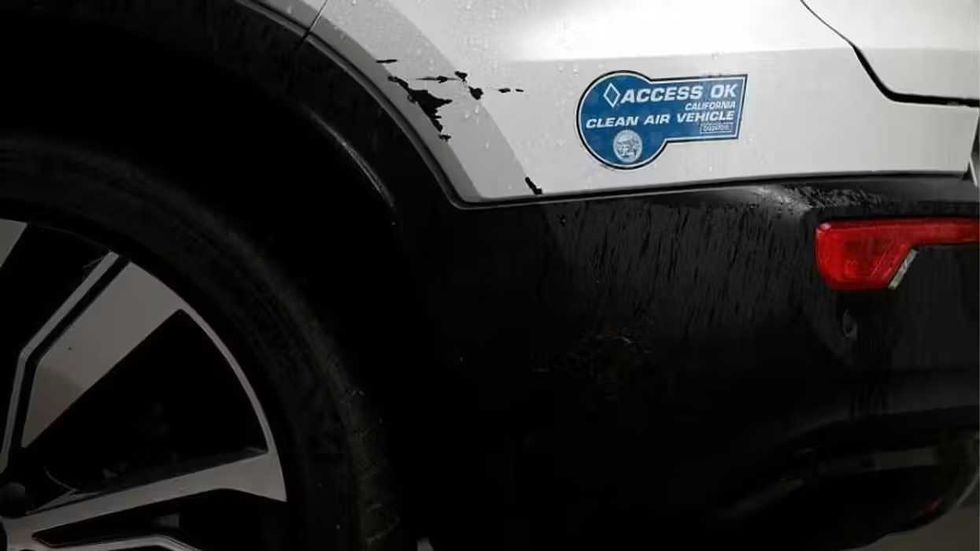Fake fuel economy has got to go.
That’s the message of a recent decision by the Eighth U.S. Circuit Court of Appeals. Sent to the scrap heap: a Biden-era Department of Energy rule that critics say wildly inflated the fuel economy ratings of EVs — giving them an unfair regulatory advantage over gasoline and hybrid vehicles.
The court’s ruling was clear and direct: Federal agencies cannot manipulate timelines or definitions to advance a policy agenda without proper authorization from Congress.
This is a major correction to how the U.S. government measures vehicle efficiency, with consequences for automakers, consumers, and the future of the EV market.
Efficiency inflation
The case was brought by 13 Republican attorneys general, who argued that the DOE’s formula for calculating EV efficiency was misleading and legally indefensible. The court agreed, ruling that the Biden administration overstepped its authority by continuing to use an outdated, artificial formula that inflated electric vehicle performance under federal fuel economy standards.
At stake is the credibility of how America measures vehicle efficiency — a key driver in regulatory decisions that shape everything from automaker product lines to what cars consumers can buy.
For years, the DOE’s so-called petroleum equivalency factor has been used to translate electric power into miles-per-gallon equivalents. But the formula wasn’t based on realistic energy comparisons. Instead, it massively overstated how far an EV could travel on the energy equivalent of one gallon of gasoline — often rating electric cars above 100 MPGE, regardless of actual energy costs or grid efficiency.
Credits as currency
Rather than immediately fixing this issue, the Biden administration’s DOE planned a slow phase-out of the inflated metric between model years 2027 and 2030. That delay allowed automakers to continue claiming exaggerated efficiency numbers — and collecting fuel economy credits that made it easier to comply with the federal Corporate Average Fuel Economy standards.
Why does that matter? Because those credits act as a form of regulatory currency. A company that racks up credits through high-efficiency vehicles can use them to offset the sale of less efficient models or even sell them to other automakers.
In other words, the inflated EV math didn’t just look better on paper — it saved automakers millions of dollars in potential penalties while giving policymakers a talking point about “historic progress” in fuel efficiency that wasn’t based on real-world performance.
A direct rebuke
In its 3-0 decision, the Eighth Circuit ruled that the DOE had gone beyond its legal bounds. Agencies can’t rewrite laws through policy tweaks, the judges said, even under the guise of “phasing out” old rules. The DOE was required by statute to eliminate the flawed formula entirely — not stretch it over several more years of inflated numbers.
The court’s ruling was clear and direct: Federal agencies cannot manipulate timelines or definitions to advance a policy agenda without proper authorization from Congress.
That’s a significant rebuke not just to the DOE, but to a broader pattern of regulatory overreach that has characterized much of Washington’s EV push.
For the states that brought the lawsuit, the decision represents a major win for transparency, accountability, and consumer protection.
Pivoting on EVs
The implications for automakers are enormous. For years, inflated EV efficiency numbers helped carmakers meet federal fuel economy targets and avoid costly fines. Without that regulatory buffer, the industry will need to adapt quickly.
Automakers may now lose the valuable fuel economy credits they’ve relied on to remain compliant with CAFE standards, forcing them to find new ways to meet efficiency goals. That shift will require genuine engineering improvements — advances in aerodynamics, weight reduction, and hybrid technology — rather than relying on inflated paper-based advantages.
This change could also prompt a broader reassessment of electric vehicle strategy. If the regulatory math no longer tilts in favor of EVs, many manufacturers may slow their rollout plans or diversify their portfolios to include more hybrids and high-efficiency gasoline models.
The timing is significant: EV demand has cooled, dealer inventories are building up, and consumer interest has leveled off. Automakers such as Ford, General Motors, and Volkswagen have already scaled back or delayed certain EV programs in response to slower-than-expected sales and ongoing infrastructure limitations.
RELATED: Sticker shock: Cali EV drivers lose carpool exemption
 Justin Sullivan/Getty Images
Justin Sullivan/Getty Images
Consumer transparency
For everyday drivers, this ruling doesn’t ban EVs — but it brings more honesty to the system.
Consumers deserve accurate information about vehicle efficiency, cost of ownership, and environmental impact. Inflated fuel economy ratings distort that picture, making EVs appear more efficient than they are when accounting for charging losses, battery manufacturing, and electric grid emissions.
Now, car buyers can make more informed choices — whether that’s a hybrid, plug-in hybrid, or traditional gasoline vehicle.
In the long term, this ruling could encourage a broader mix of technology rather than a forced, one-size-fits-all transition to battery electrics.
The fight to come
This case isn’t just about EVs. It’s about how much power federal agencies should have to rewrite laws without Congressional oversight.
For decades, Washington has leaned on regulatory agencies to shape environmental and energy policy — often through complex formulas that most Americans never see. But as the Eighth Circuit emphasized, the ends don’t justify the means.
Even if the goal is cleaner transportation, the process has to respect legal boundaries. When agencies overreach, courts must intervene to restore balance.
This decision reinforces an important principle: Policy must be grounded in law, not ideology. And in a country that values free markets and consumer choice, regulations should enhance transparency, not distort it.
The ruling leaves several key questions unanswered, but it is likely just the beginning of a much larger policy fight. Congress could attempt to step in by rewriting the laws that govern fuel economy standards, giving the DOE clearer authority to define how electric vehicle efficiency is calculated. However, such legislative efforts would almost certainly face significant political gridlock in an already divided Congress.
Much-needed realism
Automakers, meanwhile, are expected to take a hard look at how they allocate their research and development budgets and how they plan future vehicle lineups.
Companies heavily invested in electric vehicles have shifted strategies, focusing more on hybrids, plug-in hybrids, and improved gasoline technologies — especially in markets where EV sales have already shown signs of slowing or flattening.
Finally, the court’s reasoning may open the door to further challenges that could include renewed scrutiny of EPA emissions standards and federal tax credits, both of which critics argue have tilted the market in favor of electric vehicles rather than allowing consumer demand and market forces to guide the transition naturally.
The Eighth Circuit’s decision is a defining moment for the future of American automotive policy. It doesn’t kill the EV market — but it forces it to stand on its own merits.
Electric vehicles have their place in the market, but consumers deserve truthful efficiency data and honest cost comparisons. Inflated numbers and creative accounting don’t serve innovation — they undermine it.
This ruling restores some much-needed realism to the national conversation about the future of mobility. It’s a win for transparency, for accountability, and most importantly, for consumers who want to make decisions based on facts rather than politics.
Read the full article here






![Federal Investigation Targets DC Mayor’s $61K Qatar Trip, Ethics Records Missing [WATCH] Federal Investigation Targets DC Mayor’s $61K Qatar Trip, Ethics Records Missing [WATCH]](https://www.lifezette.com/wp-content/uploads/2025/08/2025.08.24-08.43-lifezette-68aad0abb4e9c.jpg)
![Viral Country Song Shows Women Aren’t Buying the Feminist Girlboss Lifestyle Anymore [WATCH] Viral Country Song Shows Women Aren’t Buying the Feminist Girlboss Lifestyle Anymore [WATCH]](https://www.boredtrashpanda.com/wp-content/uploads/2025/11/2025.11.30-06.58-boredtrashpanda-692beb1382de0.jpg)

![Rogers Says Democrats Trying to ‘Start a Color Revolution’ [WATCH] Rogers Says Democrats Trying to ‘Start a Color Revolution’ [WATCH]](https://www.lifezette.com/wp-content/uploads/2025/07/2025.07.07-01.09-lifezette-686bc6f761807.jpg)


